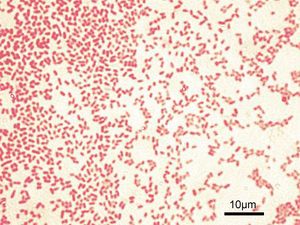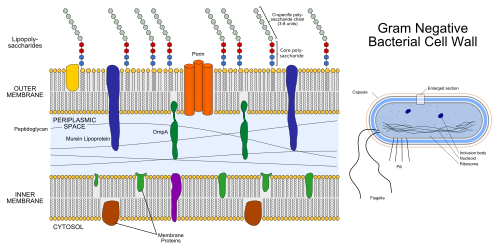جراثيم سلبية الگرام

البكتريا سلبية الگرام Gram-negative bacteria هي تلك البكتريا التي لا تحتفظ بالصبغة البنفسجية البلورية في پروتوكول صبغة گرام.[1] In a Gram stain test, a counterstain (commonly safranin) is added after the crystal violet, coloring all Gram-negative bacteria with a red or pink color. The test itself is useful in classifying two distinct types of bacteria based on the structural differences of their cell walls. On the other hand, Gram-positive bacteria will retain the crystal violet dye when washed in a decolorizing solution.
The pathogenic capability of Gram-negative bacteria is often associated with certain components of Gram-negative cell walls, in particular the lipopolysaccharide (also known as LPS or endotoxin) layer.[1] In humans, LPS triggers an innate immune response characterized by cytokine production and immune system activation. Inflammation is a common result of cytokine (from the Greek cyto=cell, kinesis=movement) production, which can also produce host toxicity.
When treated as a clade, the term "negibacteria" is sometimes used.[2]
. . . . . . . . . . . . . . . . . . . . . . . . . . . . . . . . . . . . . . . . . . . . . . . . . . . . . . . . . . . . . . . . . . . . . . . . . . . . . . . . . . . . . . . . . . . . . . . . . . . . . . . . . . . . . . . . . . . . . . . . . . . . . . . . . . . . . . . . . . . . . . . . . . . . . . . . . . . . . . . . . . . . . . . .
الخصائص

- من المكوّرات: نايسّيرياسييَا Neisseriaceae (نايسّيريا Neisseria ومواكسيلّا Moaxella)
- هوائيّة من المكوّرات: نايسّيريا، منها الغونوكوكّات Neisseria gonorrhoeae والمينينغوكوكّات Meningococcus
- مكوّرات لاهوائيّة: فايلّونيلّا Veillonella، ميغاسفيرا Megasphaera وآسيدآمينوكوكّوس Acidaminococcus
- مكوّرات الشكل، (عصيّات قصيرة) آسينيتوباكتير Acinobacter وكينغيلّا Kingella
- عصيّات هوائيّة غير تخميريّة: بسويدوموناداسييا Pseudomonadaceae (بسويدوموناس Pseudomonas، بوركهولديريا Burkholderia، ستينوتروفوموناس Stenotrophomonas، شيوانيلّا Shewanella، سفينغوموناس Sphingomonas، كوماموناس Comamonas)
- عصيّات غير بانية للبوغ (لاهوائيّة اختياريًّا) إينتيروباكتيرياسييا Enterobacteriaceae: سالمونيلّا Salmonella، شيغيلّا Shigella، إيشيريشيا Escherichia، ييرسينيا Yersinia، سيتروباكتير Citrobacter، كليبسييلّا Klebsiella، كاليمّاتوباكتيريوم Calymmatobacterium، إينتيروباكتير Enterobacter، سيرّاسيا Serratia، بروتييوس Proteus، فيبرييو Vibrio وآييروموناس Aeromonas
- عصيّات غير بانية للبوغ هوائيّة: بروسيلّا Brucella، فرانسيسيلّا Francisella، بورديتيلّا Bordetella، ليجيونيلّا Legionella، بارتونيلّا Bartonella، كوكسيِيلّا Coxiella، هيموفيلوس Haemophilus، باستوريلّا Pasteurella ومانّهامِيا Mannheimia، آكتينوباسيلّوس Actinobacilus، آيكينيلّا Eikenella، كابنوسيتوفاغا Capnocytophaga، كارديوباكتيريوم Cardiobacterium وغاردنيريلّا Gardnerella
- عصيّات غير بانية للبوغ اللاهوائيّة: باكتيروييداسِييا Bacteroidaceae
- لولبيّات (سبيروكات Spirochete): تريبونيما Treponema، بورّيليا Borrelia وليبتوسبيرا Leptospira
- ملتويات (كالحلزونيات أو أشكال أخرى): كامبيلوباكتير Campylobacter، هيليكوباكتير Helicobacter، سبيريلّيوم Spirillum وستريبتوباسيلّوس Streptobacillus، ريكيتّسيا Rickettsia (تعيش داخل الخلايا)، إيرليشيا Ehrlichia، كلاميدياسييا Chlamydiaceae، ميكوبلاسماتاسييا Mycoplasmataceae.
انظر أيضاً
الهامش
- ^ أ ب Salton MJR, Kim KS (1996). Structure. in: Baron's Medical Microbiology (Baron S et al., eds.) (4th ed.). Univ of Texas Medical Branch. ISBN 0-9631172-1-1.
- ^ Cavalier-Smith T (2006). "Rooting the tree of life by transition analyses". Biol. Direct. 1: 19. doi:10.1186/1745-6150-1-19. PMC 1586193. PMID 16834776.
{{cite journal}}: CS1 maint: unflagged free DOI (link)
- الهامش
- درس مبدئي في العلوم (بالإنجليزية) نشره the NCBI, وهي مطبوعة حكومية أمريكية, مشاع.
